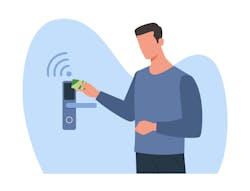Why Credential Modernization Is the Next Big Security Move
Key Highlights
- Legacy cards are a liability: Proximity and iCLASS® credentials are easily cloned or compromised, opening the door to physical and cyber intrusions.
- Delaying upgrades is costly: Breaches linked to outdated authentication can trigger multimillion-dollar losses, regulatory penalties, operational disruptions, and reputational damage.
- A phased, user-focused approach works: Gradual rollouts, risk-based credential selection, and strong user adoption strategies make modernization achievable without disrupting operations.
Outdated authentication methods are more than a nuisance for end users and IT systems – they’re a liability. Our digital identities are much more complex compared to just a few years ago, and we must consider the advancement of GenAI-related security incidents. 95% of organizations experienced some form of deep-fake incident in 2024, highlighting the rise of this new type of identity security concern. As cybercriminals grow more sophisticated, the tools we use to protect physical and digital access must evolve in kind. Yet many organizations still rely on legacy credentials like proximity and iCLASS® cards, exposing themselves to unnecessary risk.
The problem is that many in the industry have grown numb to the unabating stream of data breaches, but the consequences continue to mount. Cybercrime will cost the world $23 trillion by 2027, an increase of 175% from 2022. Even further alarming, 22% of all breaches can be traced back to stolen credentials, one of the most common initial access vectors. This authentication gap needs to be patched, and robust data and identity protection solutions need to include modern credentials. For executive leaders tasked with managing enterprise risk, the message is clear: credential modernization is no longer optional; it’s urgent.
Outdated Authentication Is Riskier Than You Think
Whether it’s compatibility requirements, budget constraints or resource limitations, proximity cards remain a functional option for many organizations. Upgrading authentication systems seems too costly and time-consuming if the legacy system is sufficient. The sufficiency comes at a cost, however.
Proximity cards, still widely used across industries, transmit fixed identifiers without encryption. This makes them easy targets for cloning using inexpensive tools. iCLASS cards, while designed initially with encryption, have also been compromised through advanced emulation techniques and reader tampering.
These vulnerabilities are not theoretical. Once cloned, these credentials can be used to gain physical access to facilities and escalate to digital systems – often within minutes.
In the education sector, the risks are compounded by the growing reliance on connected devices and digital infrastructure. The average educational organization now depends on a vast network of smart technologies to support online learning, smart classrooms, and administrative systems. This expanded digital footprint has made schools and universities prime targets for cybercriminals. According to Verizon’s 2025 Data Breach Investigations Report (DBIR), threat actors using stolen credentials to compromise educational institutions account for about 24%.
While the industry may typically have constrained cybersecurity resources, it’s pertinent that as digitization continues to affect educational environments, the authentication methods evolve to defend students, faculty and administrators accordingly.
Upgrading Might Feel Costly – But Doing Nothing Costs More
Delaying the transition to secure credentials can have far-reaching consequences that go beyond just financial loss, though it should be noted that the global average cost of a data breach hit a record $4.88 million in 2024. Additional ramifications for delaying an upgrade include:
- Regulatory exposure: Institutions handling sensitive data – such as healthcare providers, financial institutions, and universities – face increasing scrutiny under HIPAA, GLBA, FERPA, and international data protection laws. Non-compliance can result in fines, lawsuits, and loss of accreditation.
- Operational disruption: In manufacturing or research environments, unauthorized access can lead to system manipulation, downtime, or intellectual property theft. For example, a compromised badge in a pharmaceutical lab could allow access to proprietary drug formulas or disrupt production lines. Reputational damage: For higher education institutions, a breach can erode trust with students, faculty, and donors. In 2024 alone, ransomware attacks on educational institutions rose by over 35%, with 217 incidents reported. These attacks often begin with compromised credentials.
Delaying the transition to secure credentials can have far-reaching consequences that go beyond just financial loss, though it should be noted that the global average cost of a data breach hit a record $4.88 million in 2024.
A Realistic Path to Stronger, Smarter Access Control
Rather than waiting for a breach to force change, security leaders can take a proactive, phased approach to upgrading credentials away from proximity or iCLASS cards. Here’s how:
1. Approach Migration in Phases to Avoid Disruption
Modern credential readers often support both legacy and encrypted credentials, allowing for an interoperable, gradual rollout. For example, encrypted smart cards can be introduced in high-risk areas – like research labs, executive suites, or server rooms – while legacy cards are phased out.
This approach minimizes operational disruption and spreads costs over time, aligning with budget cycles and business priorities. It also allows IT and security teams to test and refine deployment strategies before scaling across the entire organization.
2. Align Credential Types with Risk Profiles
Different environments require different authentication strategies. In higher education, where staff and students access shared workstations, labs, and learning platforms, mobile credentials or FIDO-based passkeys offer secure, passwordless access that’s both fast and user-friendly.
In healthcare, clinicians need rapid, secure access to electronic health records (EHRs), medication dispensing systems, and diagnostic tools. Smart cards with advanced encryption or tap-and-go mobile credentials can streamline workflows while maintaining compliance with HIPAA and other regulations.
By conducting a credential audit, organizations can identify vulnerabilities and tailor solutions – whether that means replacing iCLASS cards, eliminating passwords, or integrating biometric authentication.
3. Prioritize User Adoption and Experience
New security measures are only effective if used, so it’s vital to educate users before, during and after deployment. Mobile credentials, which leverage smartphones and digital wallets, offer a familiar and low-friction experience. They also enable IT teams to manage permissions remotely, streamlining onboarding and offboarding.
Training and communication are key. Executive buy-in, combined with targeted user education, ensures smoother adoption and reduces the risk of workarounds. Consider launching pilot programs in select departments, gathering feedback, and iterating before full deployment.
Making Credential Modernization a Leadership Priority
Credential modernization is not just a technical upgrade; it’s a strategic imperative. Cybersecurity leaders are uniquely positioned to champion this transformation by setting a clear vision that aligns secure authentication with broader organizational goals, such as risk reduction, regulatory compliance, and operational resilience.
Organizations must empower IT and security teams to evaluate, pilot, and implement new credentialing technologies without being hampered by budgetary or bureaucratic constraints.
Ultimately, when leadership takes ownership of credential modernization, it signals to stakeholders that security is not just an IT concern, but a core business priority.
The attack surface is expanding, and legacy credentials are a glaring weak point across industries. The decision to modernize access control is not just about technology – it’s about risk management, compliance, and resilience.
Whether overseeing a university campus, a hospital network, or a global enterprise, the time to act is now. Don’t wait for a breach to decide for you.
About the Author

David Cottingham
president of rf IDEAS
David Cottingham is president of rf IDEAS and a security product development and management veteran with over 25 years of experience in the security space. He previously held positions at AT&T, CDW, West Corporation and EarthLink before becoming President of rf IDEAS in 2016. David has a bachelor’s degree in engineering from the University of Wisconsin-Madison and an MBA from Northwestern.



